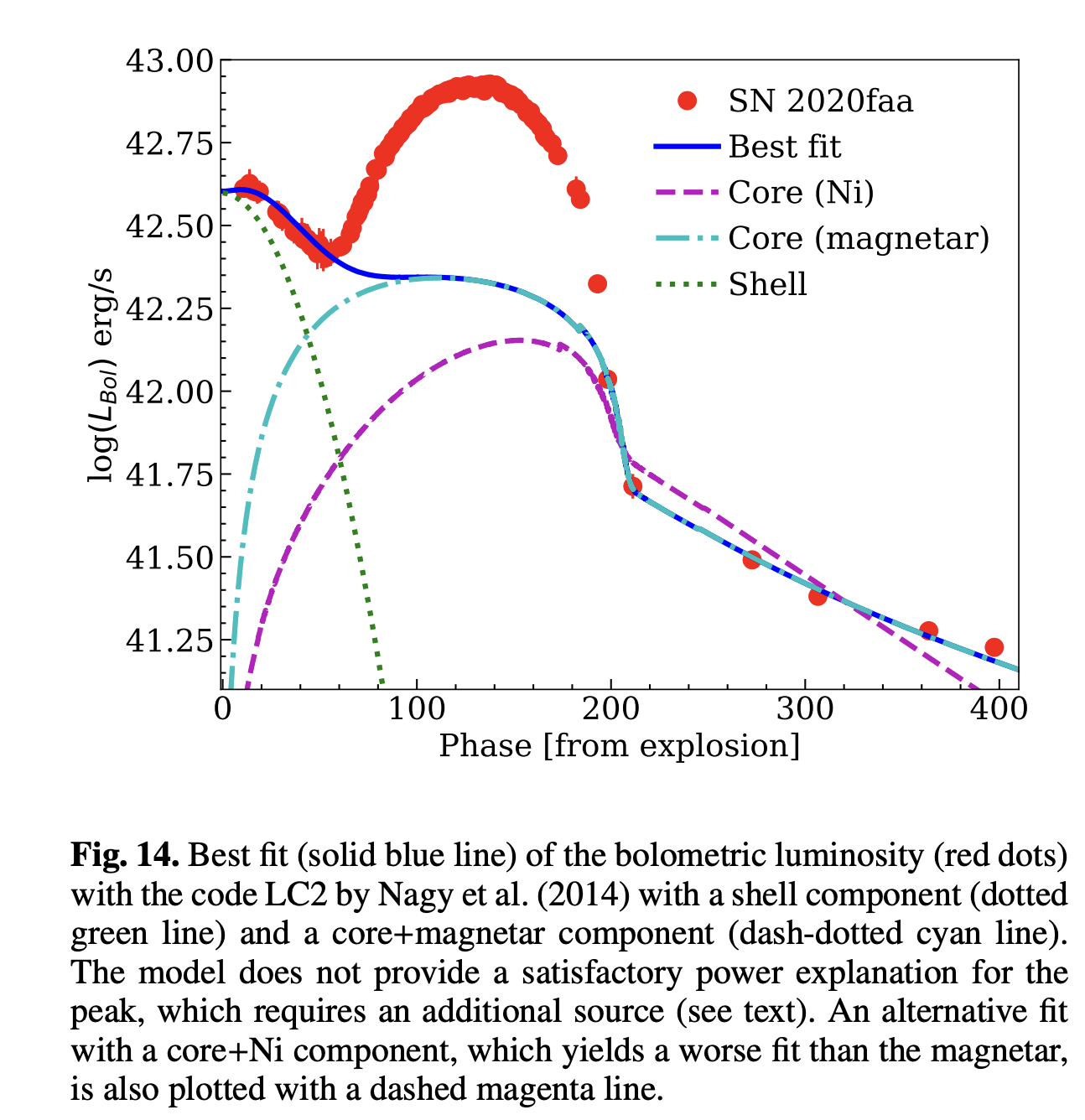Padova-Asiago Supernova Group
Highlights
A hidden shock powering the peak of SN 2020faa
I. Salmaso et al. 2023, Astron.Astrophys (link to pdf)
The link between the fate of most massive stars and the resulting supernova (SN) explosion is still debated, also because of the ambiguity of the light curve powering mechanisms. When they explode as SNe, the light curve luminosity is typically sustained by a central engine (radioactive decay, magnetar spin-down, or fallback accretion). However, since massive stars eject considerable amounts of material during their evolution, there can be significant contribution from interaction with the previously-ejected circumstellar medium (CSM). Reconstructing the progenitor configuration at the time of explosion requires a detailed analysis of the long-term photometric and spectroscopic evolution of the related transient. In this paper we present the results of our follow-up campaign of SN 2020faa that, because of the high luminosity and peculiar slow light curve, is candidate for having a massive progenitor. We present the spectro-photometric dataset and investigate different options to explain the unusual observed properties. We compute the bolometric luminosity of the supernova and the evolution of its temperature, radius, and expansion velocity. We also fit the observed light curve with a multi-component model to infer information on the progenitor and the explosion mechanism. Reasonable parameters are inferred for SN 2020faa with a magnetar of energy Ep = 1.5(+0.5,-0.2) x 10^50 erg and spin-down time t(spin)=15+/-1 d, a shell mass M(shell) = 2.4(+0.5,-0.4) Msun and kinetic energy Ekin(shell) = 0.9(+0.5,-0.3) x 10^51 erg, and a core with M(core) = 21.5(+1.4,-0.7) Msun and Ekin(core) = 3.9(+0.1,-0.4) x 10^51 erg. In addition, we need an extra source to power the luminosity of the second peak. We find that hidden interaction with either a CSM disc or with delayed, choked jets is a viable mechanism to supply the required energy.
I. Salmaso et al. 2023, Astron.Astrophys (link to pdf)
The link between the fate of most massive stars and the resulting supernova (SN) explosion is still debated, also because of the ambiguity of the light curve powering mechanisms. When they explode as SNe, the light curve luminosity is typically sustained by a central engine (radioactive decay, magnetar spin-down, or fallback accretion). However, since massive stars eject considerable amounts of material during their evolution, there can be significant contribution from interaction with the previously-ejected circumstellar medium (CSM). Reconstructing the progenitor configuration at the time of explosion requires a detailed analysis of the long-term photometric and spectroscopic evolution of the related transient. In this paper we present the results of our follow-up campaign of SN 2020faa that, because of the high luminosity and peculiar slow light curve, is candidate for having a massive progenitor. We present the spectro-photometric dataset and investigate different options to explain the unusual observed properties. We compute the bolometric luminosity of the supernova and the evolution of its temperature, radius, and expansion velocity. We also fit the observed light curve with a multi-component model to infer information on the progenitor and the explosion mechanism. Reasonable parameters are inferred for SN 2020faa with a magnetar of energy Ep = 1.5(+0.5,-0.2) x 10^50 erg and spin-down time t(spin)=15+/-1 d, a shell mass M(shell) = 2.4(+0.5,-0.4) Msun and kinetic energy Ekin(shell) = 0.9(+0.5,-0.3) x 10^51 erg, and a core with M(core) = 21.5(+1.4,-0.7) Msun and Ekin(core) = 3.9(+0.1,-0.4) x 10^51 erg. In addition, we need an extra source to power the luminosity of the second peak. We find that hidden interaction with either a CSM disc or with delayed, choked jets is a viable mechanism to supply the required energy.
